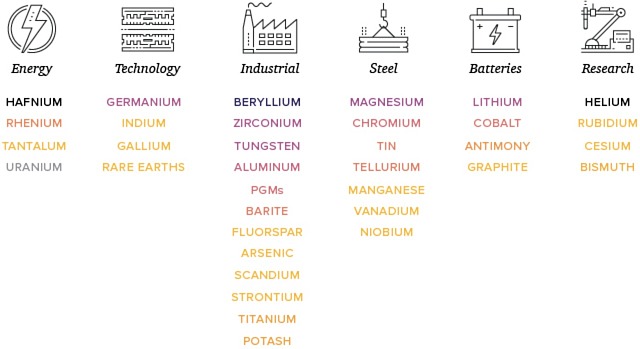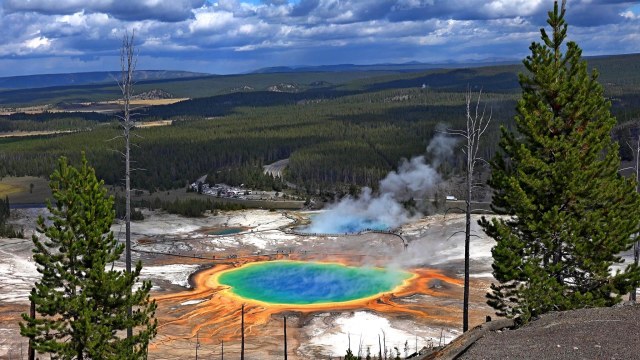Donald Trump’s executive order generates list of 35 minerals deemed critical for national security and economic prosperity

Executive order #13817: ‘A federal strategy to ensure secure and reliable supplies of critical minerals’ has led to the creation of a list of 35 minerals deemed critical for national security and economic prosperity.
The United States has published a list of 35 “critical minerals” which its government agencies say are “vital to the nation’s security and economic prosperity”.
The drafting of such a list was ordered by the US President Donald Trump under executive order 13817 late last year, who then tasked the US Department of the Interior and the Secretary of Defence to publish a list of mineral commodities that are vital to US interests.
The list includes commodity industry hotshots such as lithium, cobalt, graphite and zinc, as well as lesser-known minerals such as niobium, gallium and manganese.
The list also includes a host of rare earth minerals such as rhenium and rubidium — minerals which Japan recently discovered in substantial quantities.
Historically important elements such as uranium, titanium and zirconium also made the list given their extensive use in nuclear applications.
Under the executive order, a critical mineral is defined as: “a non-fuel mineral or mineral material essential to the economic and national security of the US, the supply chain of which is vulnerable to disruption.”
The definition therefore excludes commodities such as oil and gas.
Alleviating dependency
According to the US Department of the Interior, “dependency of the US on foreign sources creates a strategic vulnerability for both its economy and military to adverse foreign government action, natural disaster, and other events that can disrupt the supply of these key minerals.”
Given the fears expressed by so-called “disruption” and “foreign government action,” the US intends to alleviate its dependence on foreign imports.
The major reason for the creation of the list is likely to be the strong dependence of US manufacturing on foreign imports of various commodities including new-age energy facilitators such as lithium, cobalt and graphite in particular.

The list of the 35 minerals and their current primary use.
The list also includes aluminium, used in almost every sector of any developed economy; platinum which is used for catalytic agents; and rare-earth elements, currently used in batteries and electronics. Other potential key elements include gallium, used in semiconductors and niobium, used to create superalloys.
One of the cornerstone US agencies that “provided technical input” in compiling the list, and also responsible for ensuring the US has access to the commodities it needs to maintain its global superpower status, is the US Geological Survey (USGS).
The formally-stated goal of the USGS is to “provide science about the natural hazards that threaten lives and livelihoods; the water, energy, minerals, and other natural resources we rely on.”
“The expertise of the USGS is absolutely vital to reducing America’s vulnerability to disruptions in our supply of critical minerals,” said Dr Tim Petty, assistant secretary of the Interior for Water and Science.
Critical elements breeding early criticism
According to commodity industry analysts, US policymakers will use the list as a targeting system to identify which resource projects should be approved and assisted with government grants to break the country’s dependence on foreign minerals.
The Trump administration wants to identify new domestic sources of critical minerals and to increase domestic exploration, mining and recycling. The ultimate aim is to empower US explorers and miners with streamlined leasing and permitting for new exploration project and mines.
One potential eventuality is that currently restricted ecologically-sensitive areas such as the Arctic National Wildlife Refuge in Alaska and parts of Yellowstone National Park may now be opened up to toxic exploration methods as a means of maintaining US dominance and helping the US to alleviate dependence on foreign imports.

Yellowstone National Park could become open for mineral exploration.
Adding credence to the pro-mining mantra now sweeping the US and in response to recent calls for a ban on all mining in Yellowstone, Tammy Johnson, executive director of the Montana Mining Association said: “At a time when the US is becoming more dependent on foreign sources of strategic and critical minerals from countries like China, the US should be opening more lands to mineral entry, not closing them.”
Some critics have called Donald Trump’s original executive order as protectionist, paranoid and “akin to what the Soviet Union would consider doing.”
Pursuing complete national self-sufficiency could potentially accelerate commodity exploration in environmentally-sensitive areas and undermine natural habitats at the expense of perceived economic prosperity which could just as easily be obtained by collaborating with foreign nations, as opposed to chasing complete self-sufficiency.
Under President Trump’s executive order, the US Commerce Department is responsible for organising the mass of interagency responses into a final report which is due later this year on August 16th, 2018.
The agency’s report is expected to include:
- a strategy to reduce the nation’s reliance on critical minerals
- the status of recycling technologies
- alternatives to critical minerals
- options for accessing critical minerals through trade with allies and partners
- a plan for improvements to mapping the United States and its mineral resources
- recommendations to streamline lease permitting and review processes
- ways to increase discovery, production, and domestic refining of critical minerals.
One of the expected conclusions in the final report is for the US Bureau of Land Management (BLM) to adjust its existing permitting processes related to minerals development as well as eventual mining activity.
Critics fear that the BLM and the Department of Commerce will recommend opening up pristine areas of Alaska and Yellowstone National Park to exploration and giving the green light for mining activity to go ahead in sensitive areas that contain sources of freshwater, thereby leading to extensive levels of water, land and air pollution.
